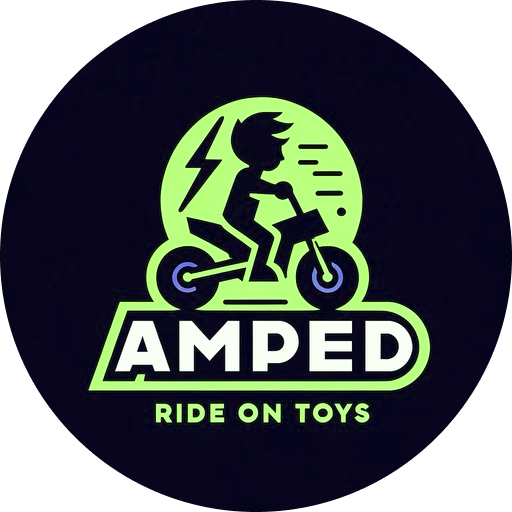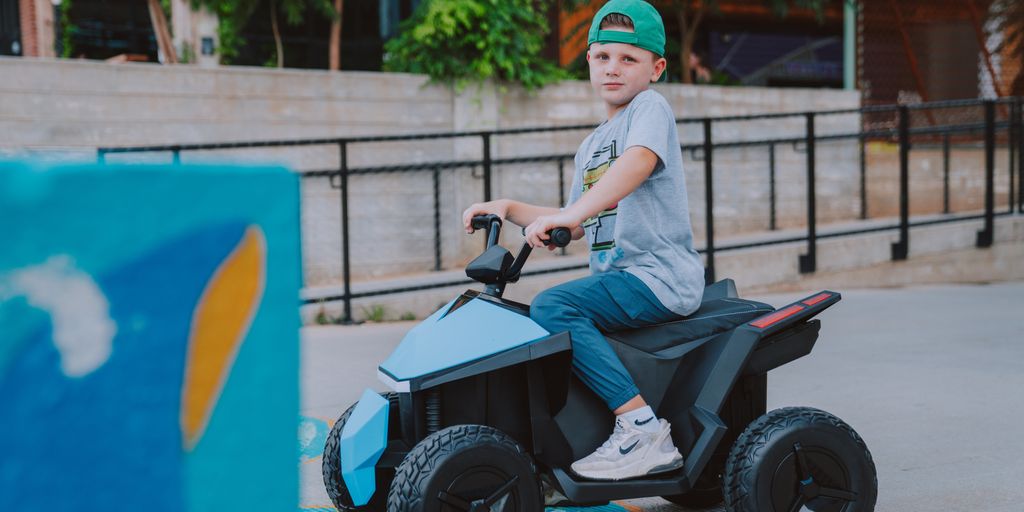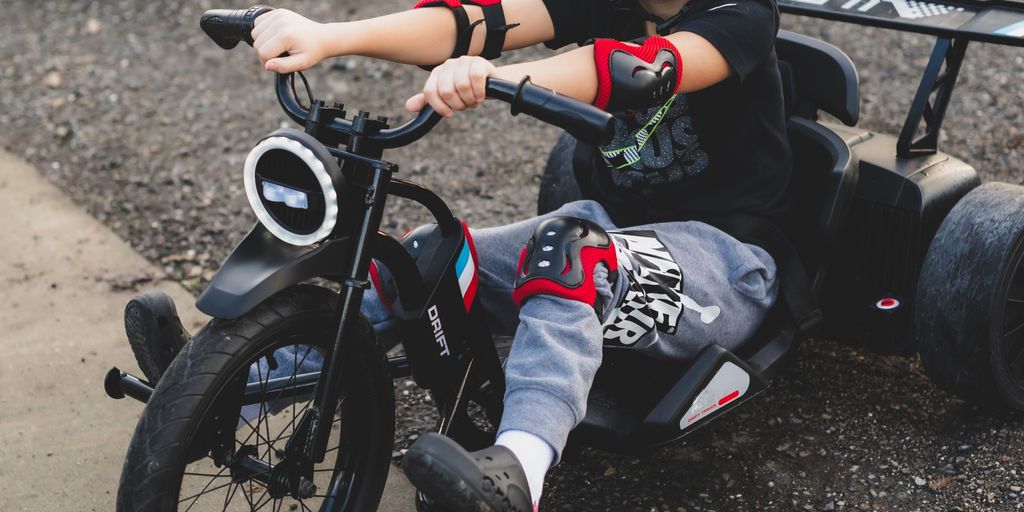Got a 24v ride on toy that your kiddo loves? Awesome! These things are super fun, but like anything with a motor and a battery, they need a little looking after to keep them going strong. You want to make sure your 24v ride on toys last, right? This article is all about how to keep those wheels spinning and that battery charged, so your little driver can enjoy their ride for a long time.
Key Takeaways
- Proper battery care is a must for your 24v ride on toys.
- Regular cleaning and lubrication help parts move freely.
- Knowing how to fix small problems can save you hassle.
- Smart driving and storage habits make your toy last longer.
- There are cool ways to make your 24v ride on toys even better.
Powering Up Your 24V Ride On Toys
Battery Care Best Practices
Okay, so you've got a sweet 24V ride-on for your kiddo. Awesome! But let's talk batteries, because a dead battery equals one unhappy child. First off, don't let that battery sit around completely drained. That's a surefire way to shorten its life. Try to charge it up after each use, even if it wasn't a super long ride.
Here's a few things to keep in mind:
- Avoid extreme temperatures. Don't leave the battery baking in the sun or freezing in the garage.
- Handle the battery with care. No dropping or roughhousing!
- Make sure the connections are clean and secure. A loose connection can cause problems.
Charging Habits for Longevity
Charging seems simple, right? Plug it in and wait. But there's a bit more to it if you want that battery to last. Overcharging is a big no-no. Once the battery is fully charged, unplug it. Leaving it plugged in constantly can damage the battery over time. Also, use the charger that came with the ride-on. Don't try to get clever and use a different one, unless it's specifically recommended by the manufacturer.
I remember one time I used the wrong charger on my kid's toy and fried the battery. Lesson learned: stick with the original charger!
Storing Your Battery Safely
When the ride-on is going into storage for the winter (or any extended period), proper battery storage is key. First, fully charge the battery before storing it. Then, disconnect it from the ride-on to prevent any slow drain. Store the battery in a cool, dry place. Check on it every few months and give it a top-up charge if needed. This will help prevent the battery from losing its charge completely and potentially becoming unusable. If you follow these tips, you'll be cruising on your 24V ride-on tractor for years to come!
Keeping Your 24V Ride On Toys Running Smoothly
It's not just about powering up; keeping your kid's ride-on toy in tip-top shape involves some regular maintenance. Think of it like a mini-car – a little TLC goes a long way! Neglecting maintenance can lead to breakdowns and a shorter lifespan. Let's dive into how to keep those wheels turning smoothly.
Regular Cleaning Routines
Okay, let's be real – these things get filthy. From mud splashes to sticky fingers, your ride-on toy sees it all. Regular cleaning is key to preventing grime buildup that can damage moving parts.
- Wipe down the exterior with a damp cloth after each use.
- Use a mild soap solution for tougher stains.
- Pay special attention to wheels and axles, removing any debris.
I usually grab a bucket of warm, soapy water and a soft cloth. It's a quick job, but it makes a huge difference. Plus, it's a good way to spot any potential problems early on, like loose screws or cracked plastic.
Lubrication for Moving Parts
Just like any machine, your ride-on toy needs lubrication to keep things moving freely. Friction is the enemy, causing wear and tear over time. A little grease can prevent squeaks, stiff steering, and premature failure of components. You can use imaginative play to keep your kids entertained while you do this.
- Identify all moving parts: axles, steering linkages, and pedal mechanisms.
- Apply a silicone-based lubricant to these areas.
- Avoid using petroleum-based lubricants, as they can damage plastic parts.
Tire Maintenance and Inflation
Tires are your ride-on toy's connection to the ground, so keeping them in good condition is crucial. Proper inflation ensures a smooth ride and prevents excessive wear. Check the tire pressure regularly, especially if you notice the toy struggling to move or the tires looking deflated.
- Check tire pressure regularly using a tire gauge.
- Inflate tires to the recommended pressure (usually found on the tire sidewall).
- Inspect tires for cuts, cracks, or bulges, and replace them if necessary.
Troubleshooting Common Issues with 24V Ride On Toys
Okay, so your kid's ride-on toy is acting up? Don't panic! Most of the time, it's something you can fix yourself with a little patience and some basic know-how. Let's get into some common problems and how to tackle them.
Diagnosing Power Problems
Is the toy just...dead? First things first, check the obvious stuff. Is the battery properly connected? Sometimes the connectors can get loose or corroded. Give them a good wiggle and make sure they're snug. Next, check the fuse. It's usually located near the battery compartment. If it's blown, replace it with the same type and amperage.
If those are fine, grab a multimeter (if you have one) and check the battery voltage. It should be close to 24V when fully charged. If it's way lower, your battery might be the culprit. Here's a quick checklist:
- Check battery connections.
- Inspect and replace the fuse.
- Test battery voltage with a multimeter.
A low battery voltage doesn't always mean the battery is dead. Sometimes, it just needs a good charge. But if it consistently drains quickly or won't hold a charge, it's probably time for a new one.
Addressing Motor Malfunctions
Motor issues can be a bit trickier. If you hear a clicking sound but the wheels aren't turning, the motor might be struggling. This could be due to a few things. First, check for any obstructions in the wheels or axles. Sometimes grass, dirt, or even small toys can get stuck and prevent the motor from turning. If everything is clear, the motor itself might be failing. Unfortunately, motors are one of the more common failure points in these toys.
Here's what you can do:
- Inspect for obstructions around the wheels and axles.
- Listen for unusual noises coming from the motor.
- Check the motor's wiring for any loose connections.
Fixing Steering and Wheel Woes
Is the steering wonky or are the wheels wobbling? Start by checking the steering linkage. Make sure all the connections are tight and that nothing is bent or broken. Loose connections can cause sloppy steering. For wheel wobbles, inspect the tires for damage or uneven wear. Also, check the wheel bearings. If they're worn out, they can cause the wheels to wobble and make noise. Replacing worn wheel bearings can often solve the problem.
Consider these points:
- Tighten loose steering linkage.
- Inspect tires for damage and wear.
- Check and replace wheel bearings if necessary.
Extending the Life of Your 24V Ride On Toys
Smart Driving Habits
Okay, so you've got this awesome 24V ride-on toy, and you want it to last, right? Well, a big part of that is how you drive it. It's not just about flooring it everywhere (though, let's be honest, that's tempting). Think of it like this: gentle acceleration and braking are your friends. Avoid sudden stops and starts because they put a lot of stress on the motor and battery. Also, try to stick to smooth surfaces. Bumping around on rough terrain all the time will wear things out faster. Basically, drive like you care about the thing, and it'll probably last longer.
Protecting from the Elements
Leaving your ride-on toy out in the sun and rain is a surefire way to shorten its lifespan. The sun can fade the plastic and damage the battery, while rain can cause rust and corrosion. Ideally, you should store it indoors, like in a garage or shed. If that's not possible, at least cover it with a waterproof tarp. And remember, extreme temperatures aren't great either. Don't leave it out in freezing weather or scorching heat. Think of it like a pet; you wouldn't leave your dog out in the rain without shelter, would you?
When to Seek Professional Help
Sometimes, no matter how well you take care of your ride-on toy, things will still go wrong. If you're not comfortable working on it yourself, or if you've tried everything and it's still not working, it's time to call in the pros. A qualified repair technician can diagnose the problem and fix it properly. Trying to fix something you don't understand can sometimes make things worse, and you might end up causing more damage. Plus, they have the right tools and expertise to get the job done right. Follow Amped Ride on Toys on Instagram for more tips and tricks!
It's always a good idea to keep an eye on the overall condition of the toy. Check for loose screws, worn tires, or any other signs of wear and tear. Addressing these small issues early on can prevent them from turning into bigger, more expensive problems down the road.
Here's a quick checklist to keep in mind:
- Store indoors or under a cover.
- Avoid extreme temperatures.
- Regularly inspect for wear and tear.
- Don't hesitate to seek professional help when needed.
Upgrading Your 24V Ride On Toys
Ready to take your kid's ride-on toy to the next level? Upgrading can be a fun way to breathe new life into a well-loved vehicle. It's not just about making it look cooler; it's also about improving performance and extending its usability. Let's explore some popular upgrade options.
Enhancing Battery Performance
One of the most impactful upgrades you can make is to the battery. A higher-capacity battery means longer playtime, which is always a win. Consider these options:
- Upgrade to a Lithium-Ion Battery: Lithium-ion batteries are lighter and offer a more consistent power output compared to traditional lead-acid batteries. They also tend to last longer. However, they are more expensive, so weigh the pros and cons.
- Increase Amp-Hours (Ah): A battery with higher Ah will provide more runtime. For example, swapping a 12Ah battery for a 15Ah battery can significantly extend playtime. Just make sure the new battery fits in the existing compartment.
- Add a Second Battery in Parallel: If space allows, wiring two identical batteries in parallel doubles the capacity, effectively doubling the runtime. Be sure to use the same type and voltage of batteries.
Always check the manufacturer's specifications and wiring diagrams before making any battery modifications. Incorrect wiring can damage the toy's electrical system or create a safety hazard.
Adding Fun Accessories
Accessories can add a lot of enjoyment and personalization to the ride-on toy. Here are some ideas:
- LED Lights: Adding LED lights can make the toy more visible and fun to ride in the evening. You can install headlights, taillights, or even underglow lights.
- Sound Systems: A small Bluetooth speaker can allow your child to play their favorite music while cruising around. Look for weatherproof options to protect against the elements.
- Custom Decals and Wraps: Personalize the look of the toy with custom decals or vinyl wraps. This is a great way to make it unique and reflect your child's interests.
Customizing for Comfort and Style
Comfort and style upgrades can make the ride-on toy more enjoyable and visually appealing. Consider these options:
- Seat Cushions: Adding a padded seat cushion can improve comfort, especially for longer rides. Look for cushions that are easy to clean and water-resistant.
- Steering Wheel Upgrade: A new steering wheel can improve the feel and look of the toy. Consider a smaller diameter wheel for easier steering or a sporty design for added style.
- Paint Job: A fresh coat of paint can completely transform the look of the toy. Choose a durable paint that is designed for plastics and follow proper painting techniques for a professional finish. Remember to disassemble the toy as much as possible before painting for best results.
Upgrading your 24V ride-on toy can be a rewarding project. Just remember to prioritize safety and follow the manufacturer's guidelines when making any modifications. Have fun and enjoy the enhanced ride!
Safety First with 24V Ride On Toys
Supervision Guidelines
Okay, so you've got a sweet 24V ride-on toy. Awesome! But before your kiddo starts tearing up the driveway, let's talk safety. Supervision is key, especially with younger children. Never, ever leave them unattended while they're riding. It's not just about preventing accidents; it's about teaching them safe riding habits from the get-go. Think of it as driver's ed, but way more fun (and less paperwork).
Understanding Weight Limits
Every ride-on toy has a weight limit, and it's there for a reason. Overloading it can damage the motor, the battery, or even the frame. Plus, it makes the toy unstable and harder to control. Check the manufacturer's specifications and stick to them. It's not a suggestion; it's a rule. I know it's tempting to pile on a few extra kids, but trust me, it's not worth the risk. Here's a quick guide:
- Check the manual for the exact weight limit.
- Weigh your child before each ride.
- Don't let multiple kids ride if it exceeds the limit.
Exceeding the weight limit can lead to mechanical failures and potential injuries. Always prioritize safety by adhering to the manufacturer's guidelines.
Proper Riding Environments
Where your child rides is just as important as how they ride. Avoid busy streets, steep hills, and areas with obstacles like rocks or trees. A flat, paved surface like a driveway or sidewalk is ideal. Make sure the area is clear of pedestrians and other hazards. And for goodness' sake, keep them away from pools or other bodies of water. You want fun, not a rescue mission. Consider a Shepard Tank ride-on toy with a safety belt for added security.
Here are some places to avoid:
- Busy streets with car traffic
- Areas with steep inclines or declines
- Anywhere near water (pools, ponds, etc.)
Keeping kids safe while they play is super important, especially with 24V ride-on toys. These toys are a blast, but making sure your child is safe comes first. We've put together some easy tips to help you pick the right toy and keep playtime fun and worry-free. For more helpful advice on toy safety, check out our website!
Conclusion
So, there you have it! Keeping your 24V ride-on toy in good shape doesn't have to be a huge chore. A little bit of regular care, like checking the battery and cleaning things up, goes a long way. And if something does break, don't sweat it too much. Most of the time, a simple fix or a new part can get your kiddo back to cruising in no time. By following these tips, you're not just making the toy last longer; you're also making sure your little driver gets to enjoy countless hours of fun. Happy riding!
Frequently Asked Questions
How can I make the battery in my 24V ride-on toy last longer?
To make your 24V ride-on toy's battery last a long time, always charge it fully after each use, even if it was only used for a short time. Don't leave it completely empty for too long. Also, try not to overcharge it by leaving it plugged in for days on end.
How often should I clean my ride-on toy, and what's the best way to do it?
It's a good idea to clean your ride-on toy regularly, especially after playing outside. Use a damp cloth to wipe down the body and wheels. For tougher dirt, you can use a mild soap and water solution. Make sure to dry it completely afterward to prevent rust.
My 24V ride-on toy isn't working. What's the first thing I should check?
If your ride-on toy isn't moving or seems slow, first check the battery. Is it charged? Is it connected properly? Sometimes, the wires can come loose. If the battery is fine, it might be an issue with the motor, which might need a professional to look at.
What's the best way to take care of the tires on my ride-on toy?
To keep the tires in good shape, check them regularly for any cuts or wear. If your toy has air-filled tires, make sure they are pumped up to the right pressure. This helps with a smooth ride and makes the tires last longer.
Where should I store my 24V ride-on toy when it's not being used?
When you're not using your 24V ride-on toy, especially for a long time, store it in a cool, dry place. Keep it out of direct sunlight and away from rain or snow. This helps protect the electronics and the toy's body.
Can I upgrade or add things to my 24V ride-on toy?
Yes, you can often find ways to make your ride-on toy even better! You can upgrade the battery for more power or longer run times. You can also add cool accessories like lights, a radio, or even custom paint to make it unique.



Leave a comment
This site is protected by hCaptcha and the hCaptcha Privacy Policy and Terms of Service apply.